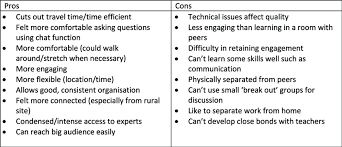In today’s fast-paced world, education has transcended the confines of traditional classrooms. The rise of technology has given birth to new modes of learning, and distance learning is at the forefront. While it’s a topic of much discussion and debate, we are here to delve deep into the world of distance learning, shedding light on its pros and cons.
Pros of Distance Learning
1. Flexibility in Scheduling
One of the primary advantages of distance learning is its flexibility. Students are no longer bound by rigid class schedules. This approach allows learners to tailor their education to their individual needs and lifestyles. Whether you’re a working professional or a stay-at-home parent, distance learning provides you with the freedom to study when and where it suits you.
2. Access to a Global Network
Distance learning transcends geographical barriers. It opens doors to a vast global network of educators and fellow students. This means that you can access courses and programs from institutions around the world, exposing yourself to diverse perspectives and expertise.
3. Cost-Effective Education
Traditional on-campus education often comes with hefty tuition fees, transportation, and accommodation costs. In contrast, distance learning offers a more cost-effective alternative. You can save on commuting expenses, textbooks, and sometimes even tuition fees, making education more affordable and accessible.
4. Self-Paced Learning
Distance learning empowers students to take control of their education. It enables self-paced learning, allowing you to progress through the material at your own speed. This is particularly beneficial for those who require extra time to grasp complex concepts or wish to expedite their learning journey.
5. Enhanced Skill Development
In the digital age, distance learning equips students with valuable tech-savvy skills. From online research to navigating learning management systems, these skills are not only crucial for academic success but also highly desirable in the job market.
Cons of Distance Learning
1. Limited Face-to-Face Interaction
One of the significant drawbacks of distance learning is the limited face-to-face interaction. Traditional classrooms provide an environment for active discussions and immediate feedback from professors. Distance learning, in contrast, can sometimes leave students feeling isolated.
2. Self-Discipline Required
While flexibility is an advantage, it can also be a double-edged sword. Distance learning demands a high level of self-discipline. Students must motivate themselves to study regularly and meet deadlines without the structure of a physical classroom.
3. Technological Challenges
Distance learning heavily relies on technology. Access to a stable internet connection, computers, and software is imperative. Technical issues or a lack of digital literacy can become barriers for some learners.
4. Limited Hands-On Learning
Certain fields of study, such as laboratory sciences or hands-on arts, may face limitations in distance learning. Hands-on experience and practical training are challenging to replicate in a virtual environment.
5. Less Immediate Support
In traditional settings, students can seek immediate assistance from professors during or after class. In distance learning, communication with instructors may not be as immediate, potentially leading to delays in clarifying doubts or receiving feedback.


